Abstract
Architecture is one of the primary historical records of ancient kingdoms around the world. From the Egyptian Empire in North Africa to Roman and Greek Empires in Europe and Han Empire in China, architecture was the major driver of civilization. These societies were keen on developing comfortable houses that would protect them from excessive heat and rainfall during the summer and extreme cold during the winter.
They also wanted appealing structures that would be admired by visitors. In this comparative study, the researcher focused on analyzing a typical Roman house in Pompeii and a traditional Chinese courtyard house. The goal was to identify similarities and differences in their architectural designs. Data used in this study was collected from secondary sources. The limited-time within which the report had to be written and the difficulty in finding experts in this field made it necessary for the researcher to rely on secondary data.
Historical records and artifacts in local archives provided more reliable and richer sources of information than interviewing people. The findings show that the two buildings had numerous similarities. The goal of the study is to conduct a comparative analysis of a typical Roman house and a traditional Chinese courtyard house.
Introduction
The architectural history of ancient kingdoms helps to understand the civilization pattern in different parts of the world and the motivation that these people had when designing their houses. The Egyptian Empire, the Roman Empire, the Greek Empire, and the Han Empire are some of the empires that made a massive historical impact on modern civilization (Barrie 52). One of the most important historical aspects of these empires is the architectural designs of their houses. Ching et al. explain that buildings in Egypt were designed differently from those in Rome and those in the ancient Chinese dynasties (49).
Despite these differences, some striking similarities exist, primarily because of the contacts that people had in these early times. At that time, North Africans interacted with Europeans through trade and wars (Temin 31). The contact led to the borrowing of ideas in the construction industry, which explains the existence of some of these similarities. In this paper, the researcher seeks to conduct a comparative analysis of a typical Roman house and a traditional Chinese courtyard house.
Comparative Analysis
Architectural Designs in the Roman Empire
The architectural design of different countries in ancient times is one of the most important factors that define their way of life. In the Roman Empire, people lived in an urban setting, primarily because of the need to enhance security. Centralized settlements meant that people could organize their forces as a unit in cases of attacks by another kingdom. Such attacks were common in that era (Kushner 74).
However, within the settlements, people lived in houses that defined their social status. The caste system was strong in this community in that era. It was rare for people to climb the social ladder, especially if one belonged to the lower caste. The community had a unique design to protect the system. Although people lived in a community system, an effort was made to ensure that the poor do not mingle easily with the rulers (Jones 46). The royals had the liberty of visiting the neighborhoods of the peasants under tight security, but measures were put in place to limit the movement of the poor into the royal’s settlement without a clear purpose. Figure 1 below shows the caste system as was propagated in the Roman Empire.
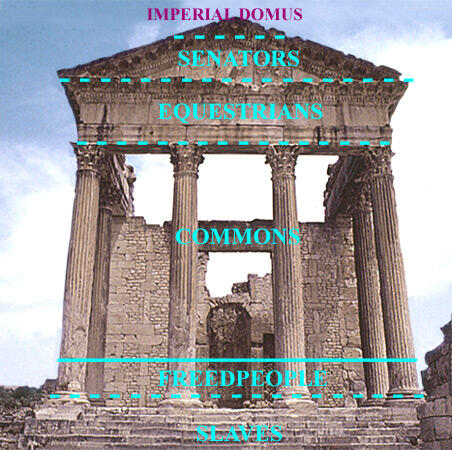
Housing structures were designed to reflect the social status of people within the Roman Empire. At the lowest level of the pyramid were the slaves. They were not allowed to own houses in this empire. They stayed in prison-like dormitories under close supervision of the Roman soldiers. At the next level of the pyramid were the freed slaves. Upon demonstration of loyalty and commitment to the development of the empire, slaves would be freed and allowed to be part of the society.
They would leave the dormitories and own small houses within the city suburbs (Temin 52). These crowded houses lacked many basic commodities. The commons or the ordinary people, which formed the majority of the community, lived in small flats within the cities.
Their houses had workshops at the back and shops in front. These houses were designed as such because the commons were the main workers. They were blacksmiths, carpenters, goldsmiths, farmers, and another physically demanding profession. Having the workshop in their backyard meant that they did not have to move a lot when going to work. They only needed to move to their backyard to start working. Their completed artwork such as furniture, utensils, farm tools, and weapons would be displayed at the shop at the front of their house. It meant that they could continue with their work as they attend to their customers as may be necessary (Harlow and Nosch 53). The design of these structures helped in improving productivity by eliminating time wastage.
Equestrians were the next step in the ladder, mainly consisting of soldiers. Although it was prestigious to be a soldier in the Roman Empire, their primary role was to ensure that the community remained secure from any potential attack. They could visit the royal palaces frequently, but they lived in the fort, which was built at the main entrance and around the city (Ching et al. 75). The location was strategic to ensure that they could act promptly in cases of inversion and ensure that the threat is neutralized before breaching the city walls. These forts were comfortable but designed in a way that made it easy for soldiers to respond to attacks with ease.
Steps were taken to ensure that they would be safe in cases of attack. At the next level of the pyramid were the senators and the wealthy businesspersons in the community. These individuals interacted with the king regularly and they played a major role in enacting laws and policies that governed the society. They lived in comfortable and large houses in the inner parts of the city where their security would be guaranteed. Their houses had underground heating systems to protect them during the winter, which shows the architectural advancement that had been realized in the community at that period.
At the apex of the pyramid was the imperial Domus, or the king. The rulers stayed in large palaces constructed in the innermost part of the city. The location of the palaces was meant to ensure that invaders would not easily take over the kingdom after killing or arresting the king. Safety, comfort, ease of movement, and luxury were the main factors that were considered when constructing palaces in this kingdom.
Having a large swimming pool in the palace was a common architectural feature of these houses, often used during hot summers (Kushner 57). They also had an advanced heating system to help maintain a normal temperature during cold winters. The paintings and decorations on the walls were part of the beautification of these buildings. The palace had large conference halls to facilitate meetings between the king and his advisors and policy-makers in the kingdom.
Architectural Designs in Traditional China
In traditional China, many dynasties existed in different periods. Some of the notable kingdoms include the Xia Dynasty, Shang Dynasty, Zhou Dynasty, Qin Dynasty, Han Dynasty, Tang Dynasty, Ming Dynasty, and Qing Dynasty among others (Que et al. 76). Although there was a consistent improvement in the architectural designs in these dynasties as time went by, some major similarities existed. Like many other kingdoms around the world, safety, comfort, security, and beauty were the main factors that defined architectural designs. The Chinese caste system, commonly known as Hukou, largely divided the population into two broad classes. There was the haves who lived in urban settings and the haves’s not who were the rural households.
Despite the existence of the caste system in this community, there was often an attempt to eliminate the gap between the rich and the poor. Although slaves had a class of their own at the lowest end of the pyramid, those in other classes had the capacity to climb the ladder based on their personal effort. The royals had their unique houses that symbolized their status in the community. These buildings were large and with huge fortresses to ensure that the ruler was safe. However, the majority of the commons had houses with striking similarities. Minor architectural designs existed, especially in terms of size and materials used for constructions based on an individual’s financial capacity (Jones 96). However, one could easily detect resemblance in the houses as shown in architectural records.
Similarities
The preliminary analysis shows that a typical Roman house has various similarities with a traditional Chinese courtyard house. It is important to analyze the similarities and factors that motivated these ancient architects to have a specific design for the house. According to Barrie, historical records show that although there was a significant interaction between the people of North Africa and Europeans during ancient times, the interaction between European empires such as the Roman Empire with that of the Far East in China and Japan was limited (64). As such, it is less likely that designs in traditional Chinese kingdoms such as Han Dynasty was influenced by Roman designers, and vice versa.
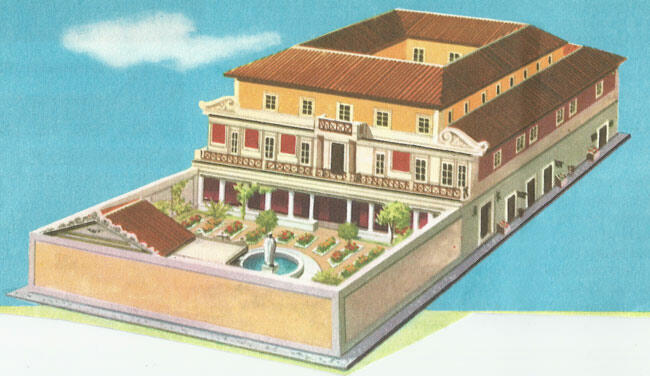
Despite the limited interaction between the two kingdoms during ancient times, it is evident that these houses had several factors in common. Figure 2 above shows a typical Roman house in Pompeii, while figure 3 below shows a traditional Chinese courtyard house. The analysis of the two figures shows several similarities. It shows that there were many common goals that architects and engineers had in common in both ancient kingdoms. Issues such as security, having a community setting, decorations, integrating nature in the designs, and the use of locally available materials are some of the striking similarities in the architectural designs of houses in the two kingdoms. It is necessary to discuss each of the factors that show similarities in the two kingdoms.
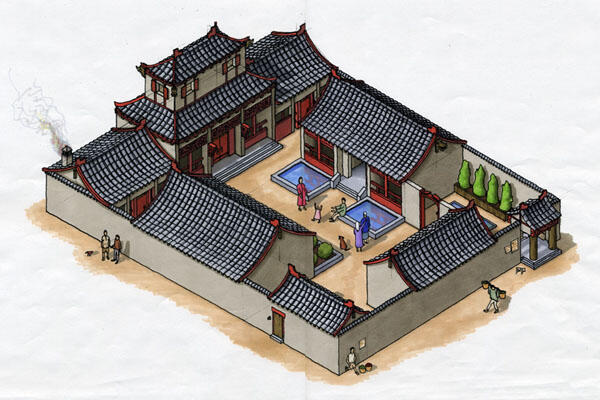
Focus on Security
One of the striking similarities between a typical Roman house and a traditional Chinese courtyard house is their focus on security. The two figures show that in both cases there are tall perimeter walls meant to limit the ability of intruders to find their way into the cities. According to Temin, in this era, it was common for one kingdom to attack another (90). Preempting a potential threat was one of the main reasons for attacks. When one kingdom felt threatened by another, they would attack it first as a way of defending their territory. Having such large fortresses was critical in slowing down an attack. Harlow and Nosch explain that the success of such attacks required an element of surprise to ensure that the enemy is caught unawares (58).
With such a tall strong wall, the kingdom could delay the entry of the enemy into the city as they plan their counterattacks. The two figures show that emphasis was placed on the strength of the perimeter walls around the community to inhibit unauthorized entries. It is evident that in both cases there are tall buildings at the furthest end of the city that acted as watchtowers. Such towers housed soldiers whose primary work was to monitor any potential threats outside the city walls. Whenever they identified a threat, they would inform the commanders that would plan a counterattack. The other buildings for other members of the community were not high-rise structures.
A Community Setting
A comparative analysis of a typical Roman house and a traditional Chinese courtyard house shows that in both cases there was the desire to live in a community setting. Instead of having the houses scattered around, the community felt comfortable having a closely-knit community setting. The need to live in such a setting was motivated by various factors, as Jones observes. One of the factors was to enhance security (78).
People living close together can form a formidable unit that can easily thwart any threat from external forces. The other factor was to boost trade. Division of labor and specialization had become a common practice during these days. Staying together in a town setting meant that people could sell what they produce to others and buy from them what they need but cannot produce (Barrie 113).
Farming was mainly done outside the dwelling places. In both cases, it was common to have slaves working on the farms. Large plantations lacked the security that the cities had, but they were guarded by soldiers to ensure that city dweller had the food they needed. Slaves would be used in these fields because their lives were not as valued as that of the other members of the community.
Living in a community setting also made it easy for the kingdoms to be governed by the rulers. They could set rules and regulations that their subjects had to observe. Soldiers would help in enforcing the law within the cities. The rulers would have spies to monitor the activities of the subjects to determine if they were engaging in activities that would sabotage the leadership of the community. Spying had become a common practice in the era in both cases. Temin explains that in both the Roman Empire and traditional Chinese kingdoms, members of the society were prohibited from marrying freed slaves (64). The community setting of these houses made it easy for the law enforcement agencies to ensure that people observed these rules. Harlow and Nosch also say that the setting also enhanced unity among people (37). They were made to realize that they shared the same destiny and as such, had to work as a unit to address the challenges they faced.
Decorations
The decoration is another common design in both a typical Roman house and a traditional Chinese courtyard house. According to Zhang, coloring meant a lot to the traditional Chinese people different colors had varying connotations. In the Roman Empire, color also meant a lot (65).
For instance, the white color was a symbol of peace (Que et al. 45). These buildings were decorated in different colors for beautification. In China, color also helped in demonstrating the position of an individual in society. The decoration was also done using items other than the use of paint. Gold was a rare and special stone in both kingdoms. It was used in decorating palaces of kings in both kingdoms. In the Roman Empire, the palaces would have their pillars plaited in gold, especially in the conference rooms and along the paths used by the king, royal families, and other foreign dignitaries (Jones 49).
It was the ultimate symbol of the wealth and power of the kingdom. The same was the case in traditional Chinese courtyard houses. The wealthy businesspersons also had golden ornaments placed strategically in their buildings. Other special stones such as silver and bronze were widely used in the two kingdoms for decorations. Figure 2 and 3 above shows how architects in the two kingdoms relied on their skills to develop unique exteriors of their structures.
Integrating Nature in Designs
A comparative analysis of figures 2 and 3 above shows striking similarities in the two structures in terms of integration of nature in the architectural designs. In both the Roman Empire and in traditional Chinese societies, people valued nature (Zhang 89). In traditional China, flowing trees were highly valued among the royals and peasants. Red flowers were the favorite among both men and women. It was a symbol of love. As such, it was common for such shrubs and small trees to be grown in the gardens of the palace and backyards of some of the wealthy members of the society. Paths leading to the palace were also decorated with flowers. It means that architects of the courtyard houses had to take into consideration these plants when developing their designs.
In the Roman Empire, there was a general appreciation of nature among members of the community. As such, it was a common practice to have specific types of trees strategically located across the city streets and next to these houses. Architects had the responsibility of ensuring that their structures blend well with nature (Temin 83). Although some plantations had to be cleared to put up such houses, it was necessary to ensure that there was no massive damage to nature. Que et al. explain that shrubs, flowers, and trees were commonly used in typical Roman houses (85). This fact is demonstrated in figure 2 above where plants are used as part of the beautification of the palace. The canopies of these trees also provided natural shade to people during hot summer.
Use of Locally Available Materials
The analysis of the two houses also shows that in both cases, the construction was based on locally available materials. Temin explains that in the Roman Empire, the use of concrete (a mixture of ballast, sand, and cement) has become a common practice in the construction sector (54).
It helped in ensuring the strength of tall and large structures. It eliminated the heavy reliance on wood when constructing walls and slabs. On the other hand, the use of wood was common in China. The use of concrete was not as common in China because of the level of advancement in the construction sector. Unlike in modern society where it is common for construction companies to import materials that they needed from other parts of the world when building complex structures, architects and civil engineers in these empires at that time had to rely on materials that were locally available (Harlow and Nosch 78).
As such, the level of creativity was limited. It explains why traditional Chinese courthouses were rarely higher than two-story because of the limited strength of the wooden structures. In Rome, the use of concrete had become common, making it possible to have slightly tall structures.
Differences
It is important to note that despite the similarities above, there were significant dissimilarities that existed between a typical Roman house and a traditional Chinese courtyard house. The difference was caused by the varying level of civilization in the two communities, the availability of materials for construction, and the technical capabilities of the architects and civil engineers responsible for developing these structures (Ching et al. 49). As explained above, there was limited interaction between the two empires, and as such, neither of them influenced the other in terms of architectural designs. They took significantly different patterns because of the challenges that each community faced, the primary goals that had to be achieved, and the architectural advancements witnessed in the neighboring kingdoms.
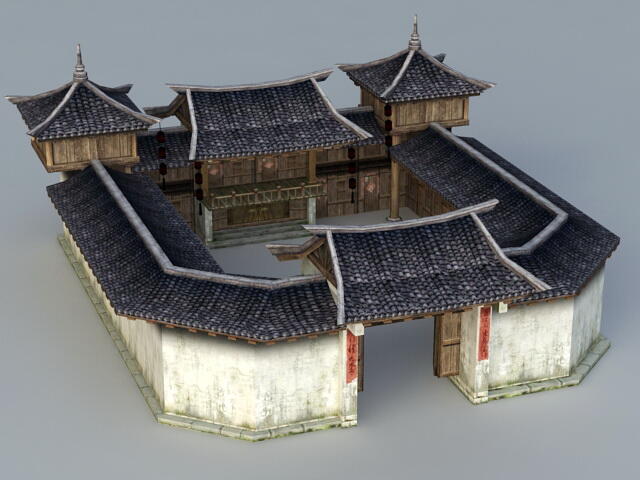
Figure 4 above is an image of a traditional Chinese courtyard house while in figure five below is a typical Roman house in Pompeii. It is evident that the physical appearance of the two structures clearly shows the major dissimilarities that they had. The main areas of difference that exist include materials used, the approach of beautification, and the shape of the roofs among others.
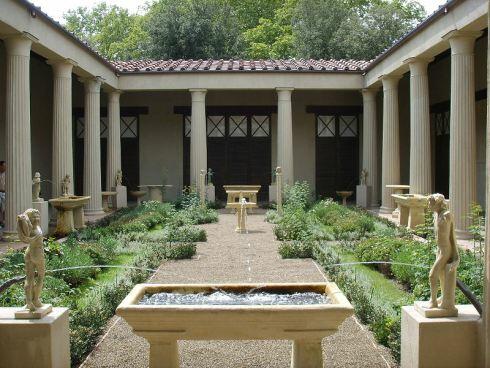
Materials Used in the Construction
One of the main differences that existed between a typical Roman house and a traditional Chinese courtyard house was the materials used. During ancient times, the Chinese had not discovered the use of cement as a critical component of construction. Que et al. explain that a traditional Chinese courtyard house would be constructed using pounded earth and wood (93). This is clearly demonstrated in figure 4 above. These were materials, which were available for construction at the time. As explained by Zhang, the use of pounded earth and wood compromised the strength of these houses significantly (78). On the other hand, in the Roman Empire cement had already been discovered as a critical construction material. Schmidt observes that the use of cement, ballast, and sand to make concretes had become common in Roman houses (44).
As shown in figure 5 above, architects and civil engineers had come to appreciate the significance of pillars to offer strength to the buildings. They no longer relied on walls as the sole strength of the house, as was the case in traditional Chinese houses. Instead, pillars were constructed along the walls to offer additional support to the entire structure. It meant that the structures could sustain greater weight than was the case in China. Que et al. point out that while the Chinese relied heavily on natural construction materials such as wood, mud, and reeds, the Roman Empire had advanced into the use of roofing tiles (113).
The Romans had developed the tegulae tiles made out of red clay, which was more effective than grass and reeds. The material lasted long and was effective in both cold winters and hot summers. These advancements made it possible to make these structures attractive, especially the palaces and houses for the wealthy Roman politicians.
Approach of Decoration
The advancement made in the Roman construction sector also defined the decorations that were used in these buildings. As shown in figure 5 above, the use of statues had become common in the Roman Empire. They had become common images in the palace and houses of top politicians. Figure 5 above shows other decorations and beautification items made of concrete used in this empire. It is also evident that the use of metal doors and windows had become common in the Roman Empire.
Kushner explains that cast-bronze grills were common in society (45). These doors would be designed to not only offer strength and security but also enhance the beauty of these structures. They would be painted based on the preferences of the owner of the house. On the other hand, traditional Chinese houses relied heavily on nature for beautification. Flowering plants and trees were used to enhance the beauty of these compounds.
The shape of the Structures
The analysis also shows that the two houses were different in terms of their shape. A typical Roman house was relatively taller than a traditional Chinese house. The difference in height was brought about by the fact that in the Roman Empire, the use of concrete walls and pillars made the structures stronger than those in China are (Jones 64). As such, it was possible to construct three or four-story buildings without compromising on the strength. On the other hand, traditional Chinese houses were constructed using mud and wood. These materials are weak and cannot support tall structures. The roofing style also differed.
In the Roman houses, the roofs had a flat shape as shown in figure 5 above. On the other hand, the traditional Chinese roof had sharp edges as shown in figure 4 above. It is one of the unique designs in most traditional Chinese houses. The design was a unique construction skill that was used by architects in different Chinese dynasties (Que et al. 78). However, its limited durability compared to that used in the Roman empire meant that it had to be replaced regularly, especially when approaching the season of heavy rains.
Conclusion
The Roman Empire and traditional Chinese dynasties had a significant impact on modern civilization around the world. One of the areas where they had a major impact was the construction sector. The study shows that Roman architecture has defined the modern era designs of construction. The use of concrete (a mixture of cement, sand, and ballast) to construct walls and pillars gained popularity during this period and it has remained popular to this day.
The study shows that a typical Roman house had numerous similarities with a traditional Chinese house. In both cases, the primary concern for the designers was to ensure that residents were protected from harsh weather conditions. It was also necessary to protect them from potential attacks by hostile communities. In both cases, designers had to rely on locally available materials. However, the study has also identified major differences in the architectural designs of the two houses. It is evident that the construction sector in the Roman Empire had made greater advancement than that in traditional China. As such, a typical Roman house was more sophisticated in terms of design and strength, and durability than a traditional Chinese courtyard house.
Works Cited
Barrie, Thomas. House and Home: Cultural Contexts, Ontological Roles. Routledge, 2017.
Ching, Francis, et al. A Global History of Architecture. 3rd ed., Wiley, 2011.
Harlow, Mary, and Marie-Louise Nosch. Greek and Roman Textiles and Dress: An Interdisciplinary Anthology. Oxbow Books, 2014.
Jones, Nathaniel. Painting, Ethics, and Aesthetics in Rome. Cambridge University Press, 2019.
Kushner, Marc. The Future of Architecture in 100 Buildings. TED Books, 2015.
Que, Ze-li, et al. Traditional Wooden Buildings in China. National and University Library, 2017.
Schmidt, Freek. Passion and Control: Dutch Architectural Culture of the Eighteenth Century. Ashgate, 2016.
Temin, Peter. The Roman Market Economy. Princeton University Press, 2017.
Zhang, Donia. Courtyard Housing for Health and Happiness: Architectural Multiculturalism in North America. Routledge, 2015.